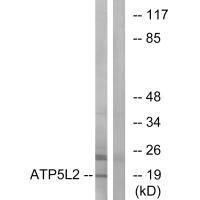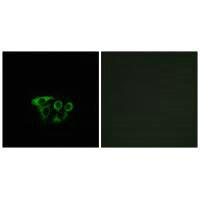Description
| Antibody Name: | ATP5L2 Antibody (PACO23390) |
| Antibody SKU: | PACO23390 |
| Size: | 100ul |
| Host Species: | Rabbit |
| Tested Applications: | ELISA, WB, IF |
| Recommended Dilutions: | ELISA:1:2000-1:10000, WB:1:500-1:3000, IF:1:100-1:500 |
| Species Reactivity: | Human |
| Immunogen: | Synthesized peptide derived from internal of human ATP5L2. |
| Form: | Liquid |
| Storage Buffer: | Rabbit IgG in phosphate buffered saline (without Mg2+ and Ca2+), pH 7.4, 150mM NaCl, 0.02% sodium azide and 50% glycerol. |
| Purification Method: | The antibody was affinity-purified from rabbit antiserum by affinity-chromatography using epitope-specific immunogen. |
| Clonality: | Polyclonal |
| Isotype: | IgG |
| Conjugate: | Non-conjugated |
 | Western blot analysis of extracts from A549 cells, using ATP5L2 antibody. |
 | Immunofluorescence analysis of A549 cells, using ATP5L2 antibody. |
| Background: | Mitochondrial membrane ATP synthase (F1F0 ATP synthase or Complex V) produces ATP from ADP in the presence of a proton gradient across the membrane which is generated by electron transport complexes of the respiratory chain. F-type ATPases consist of two structural domains, F1 - containing the extramembraneous catalytic core, and F0 - containing the membrane proton channel, linked together by a central stalk and a peripheral stalk. During catalysis, ATP synthesis in the catalytic domain of F1 is coupled via a rotary mechanism of the central stalk subunits to proton translocation. Part of the complex F0 domain. Minor subunit located with subunit a in the membrane By similarity. |
| Synonyms: | ATP synthase subunit g 2; mitochondrial; ATPase subunit g 2; ATP5K2; |
| UniProt Protein Function: | ATP5L2: Mitochondrial membrane ATP synthase (F(1)F(0) ATP synthase or Complex V) produces ATP from ADP in the presence of a proton gradient across the membrane which is generated by electron transport complexes of the respiratory chain. F-type ATPases consist of two structural domains, F(1) - containing the extramembraneous catalytic core, and F(0) - containing the membrane proton channel, linked together by a central stalk and a peripheral stalk. During catalysis, ATP synthesis in the catalytic domain of F(1) is coupled via a rotary mechanism of the central stalk subunits to proton translocation. Part of the complex F(0) domain. Minor subunit located with subunit a in the membrane. Belongs to the ATPase g subunit family.Chromosomal Location of Human Ortholog: 22q13.2Cellular Component: mitochondrion |
| UniProt Protein Details: | |
| NCBI Summary: | |
| UniProt Code: | Q7Z4Y8 |
| NCBI GenInfo Identifier: | 74762435 |
| NCBI Gene ID: | 267020 |
| NCBI Accession: | Q7Z4Y8.1 |
| UniProt Secondary Accession: | Q7Z4Y8 |
| UniProt Related Accession: | Q7Z4Y8 |
| Molecular Weight: | 11,037 Da |
| NCBI Full Name: | ATP synthase subunit g 2, mitochondrial |
| NCBI Synonym Full Names: | ATP synthase, H+ transporting, mitochondrial Fo complex subunit G2 |
| NCBI Official Symbol: | ATP5L2 |
| NCBI Official Synonym Symbols: | ATP5K2 |
| NCBI Protein Information: | ATP synthase subunit g 2, mitochondrial |
| UniProt Protein Name: | ATP synthase subunit g 2, mitochondrial |
| UniProt Synonym Protein Names: | |
| Protein Family: | ATP synthase |
| UniProt Gene Name: | ATP5L2 |
| UniProt Entry Name: | AT5L2_HUMAN |
| Antibodies |
| ATP5L2 Antibody (PACO03857) |
| Secondary Antibody |
| Anti-HRP Goat Anti-Rabbit IgG (H+L) Antibody (CABS014) |
| Recommended Products |
| Anti-FITC Goat Anti-Rabbit IgG (H+L) Antibody (CABS011) |
| Anti-HRP-conjugated Beta Actin Antibody (CABC028) |






